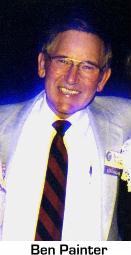Farmer's Search For A Cure Hits Medical Brick Wall
In July of 1998, 64 year-old Ben Painter was working his Beefalo farm in the scenic hill country of Wartrace, about an hour's drive south of Nashville, Tennessee. Beefalo cattle are a hybrid breed from cattle and buffalo which yield a very lean, high quality steak. Ben was tagging a Beefalo calf and got in between the calf and its mother. The half-bison cow butted Ben outside the area of his lower left lung, knocking him violently to the ground.
Characteristically, Ben got to his feet, dusted himself off, walked back to the house on the hill and took a shower. He was sore and bruised, but this was a daily part of the farm life he loved.
The pain around his left lung never went away. Nonetheless, Ben continued to work the farm, a one-man operation which thrived because of his energy and skill. Ben also found time to serve as President of the International Beefalo Association and as director of the Navy Sea Bee's Reunion '99, and to help manage the affairs of his wife Pat's mother. This same energy and drive took Ben earlier in life from overseas military service to an apprentice boiler maker to upper management within the Tennessee Valley Authority, all without the benefit of a college education. Ben was very special, a genuinely nice man of few words who commanded respect and loyalty from his men at TVA.
Pat finally convinced Ben that they should make the drive to Bedford County Medical Center, where doctors took a chest film. The film revealed fluid on the lung. The Painters then traveled to Nashville's St. Thomas Hospital, where an internist performed a thoracentesis, drawing out about three pints of fluid. The fluid had a little bit of blood. The hospital kept Ben overnight. A pulmonologist called in for a consultation the next morning took one look at Ben and said, "I'm not going to run any more tests, he's too healthy!"
The exuberance was appreciated. But what Ben Painter needed was a competent medical doctor with enough sense to look below the surface. When the pain continued, the Painters began to wonder whether their doctor's optimism was simply a mask for either apathy or incompetence.
The thoracentesis diminished the pain for awhile. In October, Ben began feeling urgent discomfort again. The Painters returned to St. Thomas, and the internist drew off another pint of fluid. A hacking cough began plaguing Ben. Sadly, his doctors saw no cause for alarm. Ben went on undeterred. That month he showed two grand champion Beefalo cattle in the ring at a national show.
The Painters returned to St. Thomas in November, and again in late December, but no fluid was drawn off on either occasion. Ben's condtion worsened. The cough got worse, more insistent, and Ben's discomfort increased. But Ben continued to work the Beefalo farm, along with all of his other chores.
In late January at St. Thomas, Ben's doctors finally chose to perform a needle biopsy. The doctor told Pat that they saw some "weird" cells in the tissue and fluid, and recommended a thoracoscopy with surgeon Johnathan Nesbitt. Dr. Nesbitt converted the thoracoscopy into a thoracotomy, with surgical entry made from the back. Dr. Nesbitt used a rib separator to get at the tumor. He was able to scrape off about 85% of the tumor from outside of the left lung. He performed a talc pleuradesis.
Pathological testing on the biopsy samples confirmed the diagnosis of malignant mesothelioma. Every doctor at St. Thomas told the Painters there was "no hope."
Dr. Nesbitt referred the Painters to Dr. Shin at M.D. Anderson. Dr. Shin offered Onconase and Doxyrubin through a Knoxville location. The Painters found Dr. Shin and M.D. Anderson highly disorganized. The hospital lost both files and films forwarded by the Painters.
Through their own research, the Painters found the H. Lee Moffitt Center. There they met with Dr. Garland, who accepted Ben as a patient. Ben was running a low grade fever and was in pain at the time of the meeting. Dr. Garland scheduled a return appointment in six weeks. Ben's pain worsened after the initial meeting with Dr. Garland. For six days, Pat kept telephoning Dr. Garland, to tell her of Ben's deteriorating health, but was unable to reach her. When Dr. Garland finally returned Pat's calls, she said, "I can't be bothered with these day-to-day cancer problems." Pat Painter is very much a genteel Southerner in manner, with a soothing voice. The Painters were troubled by Dr. Garland's attitude, and decided to continue their search for treatment for Ben elsewhere.
Pat's sister-in-law noticed an ad on television about Midwestern Regional Medical Center, in Zion, Illinois, just north of Chicago. The Painters decided to give Midwestern a try, despite the distance of about 500 miles. Their first day up at Midwestern was May 19th. The Painters were very pleased with the quality of care from the nurses there. Midwestern assigned a nurse to follow Ben's care very closely, and the Painters loved her.
Ben's doctors at Midwestern administered three rounds of Platinum and Doxil chemotherapy. Around the Fourth of July, severe nausea from the chemotherapy made it difficult for Ben to eat. Ben had already lost about fifteen pounds from his lean 160 pound frame due to his mesothelioma, and he could ill afford to lose another ten pounds from the chemotherapy.
By mid-July, Ben's white blood cell count plummeted, which his doctors counterbalanced with blood transfusions. He acquired a septic fungal infection. He could not speak because of an extremely sore throat. After a ten-day stay at Bedford County, Ben was too weak and exhausted to return for the scheduled chemotherapy hundreds of miles away at Midwestern.
Ben's family had long ago reached the exhaustion point, but they persevered. With the help of some good neighbors, Pat did her best to care for the cattle. She tried to fulfill all of Ben's other responsibilities, while at the same time pursuing pursuing treatment leads doggedly. The Painters' son Jerry spent every spare moment in helping his Mom search for treatment options. They learned the hard way that in times of crisis, your family is your best ally.
Pat drove Ben back to Zion in early August. Computerized axial tomography (CAT) scans taken at Midwestern on August 4 revealed that the tumor had neither grown nor diminished. Ben's pain and suffering had kept the tumor at bay. Ben's doctors recommended that he enter a clinical trial rather than continue with his chemotherapy regimen, but offered no guidance as to which clinical trial to choose. Meanwhile, Ben's doctors prescribed ever increasing doses of pain medication.
In mid-August, the Painters contacted this website, where they learned about Dr. Harvey Pass of Wayne State University in Detroit, Michigan. We asked Dr. Pass to assess Ben's treatment options on a Friday. Dr. Pass, with characteristic speed, grace and skill, called the Painters at home that Sunday! Dr. Pass discussed palliative radiation therapy with Pat.
Unfortunately, before Dr. Pass could examine any of Ben's records, Ben developed severe swelling in his feet and left hand. Pat grew concerned that Ben had a blood clot. Further, there was something oozing out from around the feeding tube running into Ben's stomach. The next morning, August 18, 1999, Pat rushed Ben to Bedford County Hospital. Doctors there discovered a massive blood clot in Ben's neck. Fortunately, the clot and the infection around Ben's feeding tube were treatable, and Ben's nausea from the chemotherapy continued to subside. Over the course of the next eight days, Ben's condition roller-coastered from spirited recovery to depression and back to recovery again. They spent their 42nd wedding anniversary on August 23rd at Bedford County Hospital.
The Painters looked forward to Ben's return home, which always seemed to lift his spirits and his health. Ben hoped to build up his strength so that he could treat with Dr. Pass, but realistically made hospice care arrangements.
On August 29, 1999, Ben Painter passed away at home, in his own bed, his wife and son at his side. Pat wonders what might have been had they found Dr. Pass or someone like him sooner, but the Painters cannot be faulted for their efforts. Their story illustrates that even families who are determined to educate themselves about mesothelioma and seek the best treatment options often encounter bewilderingly difficult choices, as well as ill-informed or uncaring physicians.
Son Jerry Painter's letter below speaks eloquently about the travails of a family coping with a terrible disease and unskilled medical professionals:
"Hindsight is 20/20. If we could do this all over again, we'd do it differently. This has been a wickedly eye-opening experience, and, unfortunately, my father has paid the price. I can't begin to tell you how much this has changed my family's life, and probably don't need to since you've seen firsthand the tragedy this cancer causes.
The greatest miracle in my father's life was that he married my mother. She goes by gut reaction a lot (and in this situation, that's about all we had to go on) and is uncannily correct in her decisions. She is blessed with inherent wisdom, and kindness. She totally gave up her life to nurse Dad back to health. Her feeling was that the doctors made some serious errors regarding my father's condition. While she very much liked the support staff at Zion, her experiences with the doctor, specially later in the treatment, were not positive. Her feelings were that the doctor 'washed his hands of us'."
We extend the Painters our deepest condolences.
** POSTED SEPTEMBER 9, 1999 **


